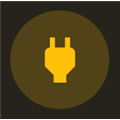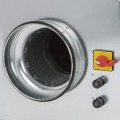A fun and musical DIY project
 Python is well-suited to tinkering with prototypes based on Yoctopuce modules: the code is compact, so it can be written fairly quickly, and open source libraries are readily available to interface external elements not directly supported by Yoctopuce modules. Today, we're going to show you just such an example...
Python is well-suited to tinkering with prototypes based on Yoctopuce modules: the code is compact, so it can be written fairly quickly, and open source libraries are readily available to interface external elements not directly supported by Yoctopuce modules. Today, we're going to show you just such an example...
| No comment yet | Read more... |
Controlling a relay from Home Assistant
 Some time ago, we looked at how to build a smart extension cord and how to use it to monitor the consumption of an electrical appliance with Home Assistant. We're going to enhance this Home Assistant integration by adding the ability to switch this extension cord from Home Assistant.
Some time ago, we looked at how to build a smart extension cord and how to use it to monitor the consumption of an electrical appliance with Home Assistant. We're going to enhance this Home Assistant integration by adding the ability to switch this extension cord from Home Assistant.
| No comment yet | Read more... |
New! Yocto-WatchdogDC & Yocto-4-20mA-rx USB-C
![]() Slowly but surely, Yoctopuce is making progress in its transition to modules with USB-C connectivity in place of the Micro-B connectors that seem to be slowly disappearing from everyday life. This week, it's the turn of the Yocto-WatchdogDC and Yocto-4-20mA-Rx modules.
Slowly but surely, Yoctopuce is making progress in its transition to modules with USB-C connectivity in place of the Micro-B connectors that seem to be slowly disappearing from everyday life. This week, it's the turn of the Yocto-WatchdogDC and Yocto-4-20mA-Rx modules.
| No comment yet | Read more... |
Improved humidity-sensitive ventilation
 A few weeks ago, we showed you how to monitor the operation of humidity-sensitive ventilation (type B) with Home Assistant. We left off with the observation that, in some cases, the mechanical humidity-sensitive setting is not ideal. So let's take a look at how a little home automation, used wisely, can improve the system's energy performance.
A few weeks ago, we showed you how to monitor the operation of humidity-sensitive ventilation (type B) with Home Assistant. We left off with the observation that, in some cases, the mechanical humidity-sensitive setting is not ideal. So let's take a look at how a little home automation, used wisely, can improve the system's energy performance.
| No comment yet | Read more... |
A connected dry box
 This week, we're going to do a simple DIY project that will be of interest to anyone involved in 3D printing. We're going to make a box for storing filaments while monitoring humidity.
This week, we're going to do a simple DIY project that will be of interest to anyone involved in 3D printing. We're going to make a box for storing filaments while monitoring humidity.
| No comment yet | Read more... |
1 ... 5 6 7 8 9 10 11 12 13 14 15 ... 20 ... 30 ... 40 ... 50 ... 60 ... 70 ... 80 ... 90 ... 100 ... 110 ... 120 ... 130 ... 140 ... 150 151


